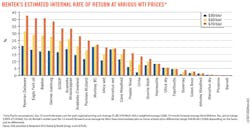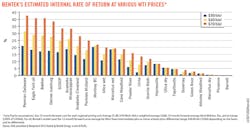Lower drilling and completion costs combined with higher crude oil prices to yield improved internal rates of return (IRR) across several US unconventional plays as of midyear compared with early 2015, Bentek Energy reported.
"Oil-rich plays produce the highest estimated returns, especially prolific shale plays in close proximity to market," Pete Compton, Bentek manager of oil and gas consulting, told participants at Benposium in Houston on June 9. Bentek is a unit of Platts.
During an interview with UOGR on the sidelines of Benposium, Compton said Permian basin activity remained robust during the oil price downturn because of its potential for stacked plays.
Meanwhile, the Bakken was harder hit by the price downturn. Although the formation produces quality oil, its distance to markets means higher costs, reducing producers' netback, he said.
"Moderate oil-price movements create significant impacts to returns in the major oil plays," Compton said, adding that wet and dry gas plays were less profitable than oil plays because of downward price pressure on gas and natural gas liquids.
Bentek calculates basin-level IRR to estimate the return a producer might expect from a typical well. Compton noted some wells will be better and some wells will be worse than the estimated IRR for a typical well. The Bentek analysis forecasts the relative viability of each region.
The IRR generally drives rig movements and drilling activity, Compton acknowledged "exogenous factors" such as hedging also influence well economics.
Bentek's IRR estimates, which cover some 20 basins, are unadjusted for hedges. The IRR model analyzes information from earnings calls, investor presentations, financial statements, and news releases.
The model devised by Bentek considers drilling and completion (D&C) costs, operating expenses, initial production rates, decline curves, production taxes, and royalty rates.
As of June, Bentek said D&C costs ranged from $4-12 million/well depending upon the unconventional play. The June IRR analysis was based on first-quarter results.
"The IRR is largely driven by what producers are reporting," Compton said. Price assumptions included the 12-month forward curve average for regional gas pricing. For NGLS, Bentek used the 12-month forward curve average for Mont Belvieu, Tex., by product prices applied to each basin's individual NLGs composition.
For oil, Bentek's model used the 12-month forward curve average for West Texas Intermediate plus or minus a basin differential. As of June 9, the oil price range was $48.06-66.17/bbl depending on the basin and its differential.
"We can get a smaller level than just the basin level," Compton said, adding Bentek has been hired to provide such analysis for specific areas within a particular play.



